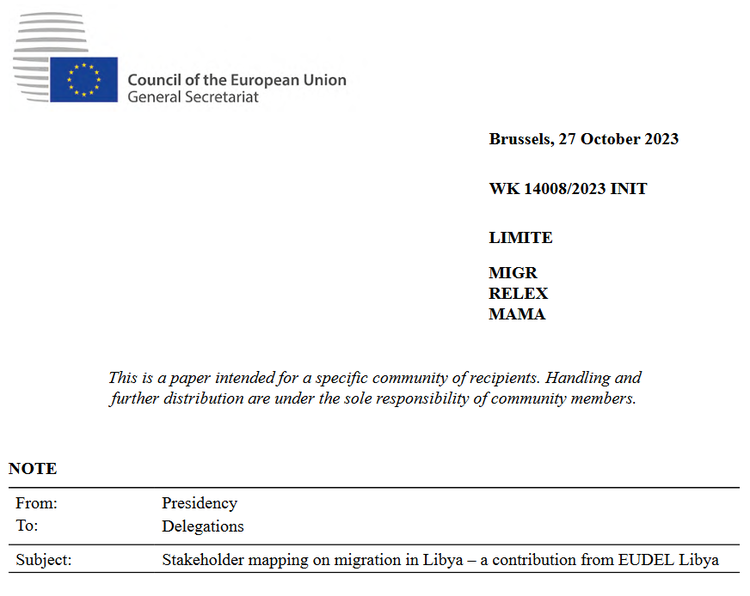The EU continues its collaboration with Libyan institutional actors on migration in full cognizance of their role in human rights violations of migrants
March 7th, 2024

The EU delegation’s latest stakeholder mapping shows once more that the EU is fully aware that most of the Libyan institutional actors that are part of the EU-funded Support to Integrated Border and Migration Management in Libya (SIBBMMIL) steering committee are part of a fragmented picture of migration governance in Libya, which is devoid of strong central institutions—especially in western Libya. It is also fully aware that militias are linked in different ways to governmental actors since migration management has become a lucrative business. The document mentions that militias benefit from the economic circuit of migration management in either formally (through contracts) and informally (slavery, extortion). The main institutional stakeholders that are involved in migration and border management and with whom the EU collaborates are Directorate for Combatting Illegal Migration (DCIM), Libyan Coast Guard (LCG), General Authority of Coastal Security (GACS), the Border Security Agency (BSA), the passport authority, Land Border Guards (LBG), Ministry of Interior (MOI) and Ministry of Foreign Affairs (MOFA).
On the controversial question of detention centers, the document mentions that DCIM, nominally controls 26 but only 5 DCs in the west and 5 in the east are active. A “hybrid” like governance of detention centers between militias and DCIM is said to be particularly prevalent in the western branches. The EU funds several international actors’ humanitarian interventions inside DCIM-run facilities, including the IOM.
The Department For Combating Settlement And Illegal Migration (DCSIM) under the West Coast branch of the Stabilisation Support Apparatus (SSA) in Zawiya are also involved in the running of detention centers in the west of the country the DC al-Mayya DC east of Zawiya, which has been at the centre of several critical human rights reports. The document highlights that the DCSIM are a formation of a conglomerate of armed groups in the West Coast Branch that have essentially been operating as a quasi-official migration unit. The SSA/DCSIM are said to be involved in human smuggling through the Busriba network. DCSIM has also engaged in sea interceptions and was the most active actor during certain periods of 2022, intercepting several thousands of migrants. As of May 2023, the document states that DCISM has reportedly been incorporated in GACS. The document points out that neither the EU nor international humanitarian partners have engaged with the DSCIM.
The report highlights the LCG’s failure to uphold standards expected of a national coast guard and mentions the footage of NGOs that documents the LCG’s dangerous conduct. In terms of actors responsible for sea interceptions, GACS’ role is highlighted as having diminished during the past year, amongst other because of the emergence of new actors. As it is widely known, the LCG cannot be viewed as one coherent institution. The Zawiya unit is for example under the command of Capt. Abdul Rahman, aka. Bija, who is on the UN Sanction Committee list. The LCG continues to be one of the main recipients of the EU’s SIBMMIL, receiving equipment and trainings.
The report illustrates that the EU has good knowledge of the main Libyan actors and how they interact. The latest incident of EU Libyan Coast Guard violently threatening SOS Humanity and the recent ruling by the Italian Court of Cassation which confirmed the unlawfulness of returns of migrants to Libya highlights once again the importance of addressing the EU’s ties with Libya. The question of who bears responsibility for the violation of migrant rights must be central to any analysis of the EU’s deterrent approach to migration in the Central Mediterranean.